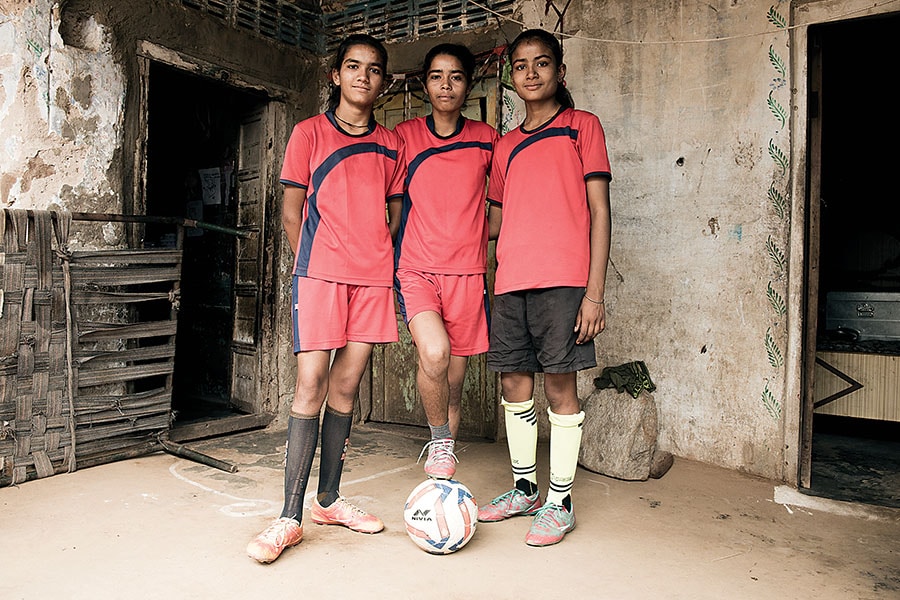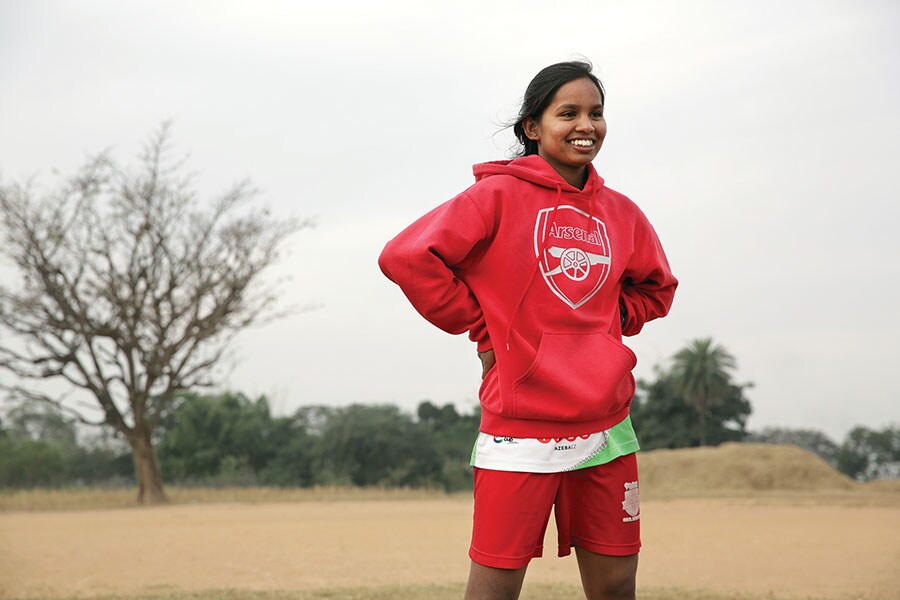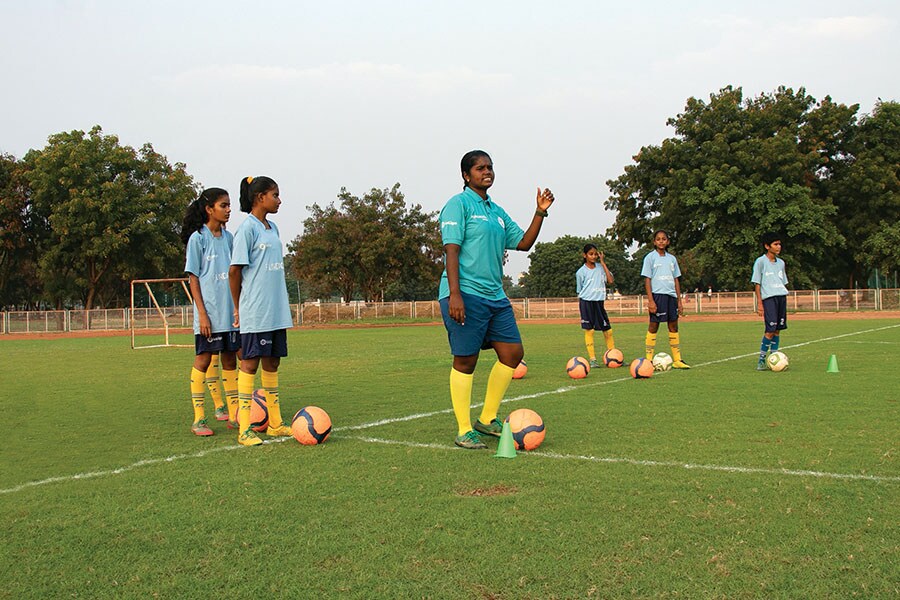Their father is an out-of-job alcoholic and mother a daily wage labourer, who earns around ₹250-300 per day. Gayatri and Savitri are both resisting attempts by their family to get them married. They want to study, get a job, and “stand on their own feet", says Gayatri, who is in class 10. They draw inspiration from their friend and neighbour Payal Prajapati, 18, whose parents got her married when she was in Class 5, but who is now is putting up a fight against her ‘gauna’ (ritual where a child bride is sent to her marital home) and staying put with her family.
Her parents are fine with the arrangement for now, and one of the main reasons is that Payal happens to be among the handful of girls from Chachiyawas to travel outside Rajasthan. She is a football player who has participated in tournaments across states, sometimes bringing home prize money up to ₹10,000 or more. This has earned social pride for her family.
Gayatri, who wants to travel to different places like Payal does, looks at football as the only way out of the clutches of her social circumstances. Playing the game, she says, gives her a sense of confidence, and helps her believe that her aspirations are within reach. “I tell my mother, ‘I’ll do all the housework, take care of my sisters, and even look after everyone else at home. Just let me study and play football’," she says, unblinking. “Just let me play."
A day before this conversation, Gayatri, Savitri and Payal played in an inter-village friendly match, which was organised by the Mahila Jan Adhikar Samiti (MJAS) to initiate the young girls of Bhawani Khera—the neighbouring village—into football training. “The ground that was allocated to the girls was full of stones and garbage. For close to a month, the girls spent an hour every day after school cleaning up," says Indira Pancholi, founding member of MJAS.
The grassroots non-profit organisation is currently training close to 500 girls aged between 10 and 20 from villages, including Chachiyawas, Hansiyawas, Kharekhadi, Tedvon ki Dhani and Padampura. About 40 percent of them are either engaged or married, says Pancholi. Their parents are largely small farmers, daily-wage earners or labourers.
![]() Sisters Savitri and Gayatri Panwar with friend Payal Prajapati (centre) from the Chachiyawas village in Ajmer, RajasthanImage: Amit Verma
Sisters Savitri and Gayatri Panwar with friend Payal Prajapati (centre) from the Chachiyawas village in Ajmer, RajasthanImage: Amit Verma
The latest National Family Health Survey-5 (NFHS-5) released on November 2021 shows that while the overall rate of child marriage in Rajasthan has reduced to 25 percent from 35 percent over the past five years, around 28 percent girls in rural areas got married before they turned 18. Around 4.2 percent girls aged between 15 and 19 were already mothers or pregnant at the time of the survey.
Ajmer, where MJAS works, is among the top three districts in the state with high prevalence of child marriage, says Pancholi. There are also other deep-rooted patriarchal practices that limit a girl’s education, relegate her to her house, and burden her with unpaid domestic responsibilities like cooking, cleaning, raising children and other housework.
The non-profit has been working at the grassroots level to help girls and women assert more agency with respect to their health, education, social and financial independence. They added football to the mix as they saw a positive correlation between girls playing the sport and higher levels of education, confidence, assertiveness, peer support, exposure, and ability to break caste and class barriers.
“When we first thought about this in 2016, we just wanted to see the girls run freely on the football ground, their hair flying, and their minds free of fear and the burden of social expectations," says Pancholi. The reason they zeroed down on football, she says, was because it is considered to be a particularly masculine sport.
There was opposition from the get-go. Be it parents and members of the village unwilling to ‘allow’ girls to play in shorts, or even be open to the idea of girls occupying public spaces for sport. Even teachers from the local government schools opposed, some even threatened the girls with termination, Pancholi claims, as they believed playing a sport will take the girls’ focus away from studies.
![]() Neeta Kumari from Jharkhand’s Hutup village says football gave her the courage to seekbigger opportunities. She is now the vice captain of the football team at Ashoka UniversityImage: Amit Verma
Neeta Kumari from Jharkhand’s Hutup village says football gave her the courage to seekbigger opportunities. She is now the vice captain of the football team at Ashoka UniversityImage: Amit Verma
“My parents didn’t allow me to play, saying football is only for boys, and they did not want me to wear shorts. They eventually agreed, reluctantly, when I said that I’ll play in a kurta churidar," recollects Sapna Gujjar, who started playing football just for the love of the sport, and then figured that if she excelled in it, she would have more agency and control over leading her life the way she wants.
Sapna, who is from Hansiyawas village, has gone on to captain Ajmer’s district team at state and national tournaments. She was selected among 600 applicants to be a youth ambassador for YuWaah, an initiative by Unicef and the government of Rajasthan. Last year, along with two others, she received the government’s Indira Priyadarshini Award of ₹1 lakh as a district topper in class XII. This has given her the confidence to pursue her ambition to play football at the national and international level, while also studying for UPSC examinations.
![]()
Route to Education
“I have seen that sport often motivates girls to continue their education," says Moncho Ferrer, who runs the Rural Development Trust (RDT) in Anantapur, Andhra Pradesh. Currently, RDT is training 2,743 kids aged between eight and 20 in football, “33 percent of whom are girls", he says. Ferrer says many girls drop out of school and have early marriages, but sport becomes an incentive that helps them continue their education, and thereby prevents child marriages. “So education and sport really work together in tandem quite well."
Franz Gastler from the US, who visited Delhi as a business consultant in 2007, but stayed back to work in the development sector, concurs with Ferrer. When he relocated to Ranchi, Jharkhand in 2008, and started a scholarship fund, it did not work as the girls in the villages were not going to or dropping out of school. According to the NFHS-5, only 55.6 percent women are literate in rural Jharkhand, out of which only 26 percent have more than 10 years of schooling. Around 36 percent of women aged between 20 and 24 were child brides.
So, back in 2009, when one of the girls expressed an interest in learning football, along with a few of her friends, Gastler realised that “the girls who were not eager to go to school earlier could be encouraged through football". He soon realised that the quality of education was also poor, which led him to launch Yuwa, a non-profit that used sports to drive education and social development in girls. Convincing the villagers, and the girls, to place trust in a foreigner was not easy, but Gastler continued with his efforts.
In 2015, along with his wife Rose, he launched a residential school that currently has about 100 girls between classes four and 12. Gastler says the organisation, whose funders include BookASmile [the charity initiative of BookMyShow] and Aequitas Investments, spends close to ₹7,000 per month for every girl, with ₹1,500 a month towards the football programme.
“Every girl in the school plays football," says Jashan Shetty, director of the football programme for Yuwa. He adds that more than 75 percent of the girls who are in class 9 and above have turned coaches for other girls in their villages. “We have around 30 girls who are coaches now, each training their own team of close to 15-20 girls. In all, there are about 500 girls playing football."
According to Shetty, the villages they work in have a strong boy preference, with girls just expected to do housework, get married early and bear children. “But the girls are extremely motivated to come out of their difficulties in life," he says, adding that girls from Yuwa have been able to move out of their villages to pursue higher education at institutions ranging from Ashoka University in Delhi to Harvard University in the US.
![]() Anjali, the only AIFF-licensed woman coach in the Anantapur academy with an AFC-C licenceImage: Amit Verma
Anjali, the only AIFF-licensed woman coach in the Anantapur academy with an AFC-C licenceImage: Amit Verma
A case in point is Neeta Kumari, 23, from Jharkhand’s Hutup village, who enrolled into Yuwa’s football programme and the school, and is now the vice captain of the football team at Ashoka University, where she is doing an undergraduate course in psychology. “I was the first girl from my village to go away from home," says Kumari, who has participated in tournaments in Spain, the US and Monaco. Despite proving her capabilities and demonstrating her passion repeatedly, her life continues to be a constant struggle against her family that wants her to settle down. Her football teammates, she says, are her only source of support. “I have had arguments with my parents, and villagers too, who cannot understand why I want to play," says Kumari, who is the only sibling among her three sisters to not get married. “I regret that I was not able to do anything to prevent the weddings of my sisters. It is very difficult to oppose one’s own family, but I have learnt to set my boundaries. I want to commit to education and prove that girls are meant for more than just marriages."
Ferrer of RDT explains that it is a long, step-by-step process to convince parents, and even the community, to let girls play. It starts, he says, by convincing them to play in the neighbourhood, then at the village level, and slowly beyond. “Parents will have a lot of doubts and questions, which you need to clarify. Small opportunities and wins, like competitions where the girl goes home with a little trophy, go a long way," he says.
At present, the RDT has 27 clubs and two development centres that not only give equipment, but also provide platforms for the kids to play league matches almost every weekend. A few kids among them, in particular those from economically weaker backgrounds, are chosen for sports scholarships. “It covers their education, health, boarding and lodging, sports equipment, competition exposure etc," says Sai Krishna Pulluru, director, Anantapur Sports Academy.
Through the LaLiga Foundation, the RDT funds a residential academy of 20 girls under 15 years from rural Anantapur for a year. “About 90 percent have passed their final examinations and 75 percent have regularly attended school. Five reading clubs have been created inside the project as well," says Elena Montoro, technical area and sustainable strategy responsible, LaLiga Foundation. According to her, football is a powerful socialising tool that encourages social growth, and helps foster tolerance, cooperation and mutual respect.
Ferrer says that through his experience, he knows sports to bring people together. “It doesn’t matter where you are from, which caste or religion you belong to. Sports is a unifying tool," he says, explaining that it has been quite effective as a gender tool as well. RDT conducts mixed-gender matches, as a result of which, he says that, while there is a long way to go, playing together with girls has “helped boys break stereotypes, and support girls both on and off the field".
The difference is evident, as Gayatri in Ajmer, all of 18, tells Forbes India, “Jaat jo bhi ho, sab ka khoon toh lal hi hai na [No matter what their caste is, isn’t their blood also red in colour?]"
![]() Seema Toppo, assistant teacher at Yuwa school in Jharkhand, had started out playing football,which helped her to thwart marriage pressures and build a career in academicsImage: Amit Verma
Seema Toppo, assistant teacher at Yuwa school in Jharkhand, had started out playing football,which helped her to thwart marriage pressures and build a career in academicsImage: Amit Verma
What about Longevity?
The real problem in ensuring girls continue playing football or develop careers related to the sport comes once they turn 18, and parents start getting entangled in social pressures.
For instance, MJAS data in Ajmer shows how the participation of the girls in football dwindles as they grow older. In Chachiyawas village, for example, there are 22 girls under 14, 22 girls under 18, but zero girls playing football over 18 years of age. Similarly, in Hansiyawas, there are 34 players under 14, 14 under 18 and just three girls over 18 years of age. In Padampura, while 40 girls play for the under 14 cohort, there are 11 for the under 18 team, and just one in the 18+ age group.
This also indicates that while it has become easier to get girls to play football, helping them have careers in the sport is difficult. At present, the RDT has 40 All India Football Federation (AIFF)-licensed coaches in Anantapur, out of whom 10 are women. Out of that, one of them, Anjali, has an AFC-C licence. Ferrer explains it is difficult for families, and also the girls to picture a career in sports management or coaching. “In a culture that just talks of doctors and engineers, you need to show them with real-life examples," he says, adding that a lot of girls prefer to continue with education and hold non-sports-related jobs.
Seema Toppo of Jharkhand is an assistant teacher in Yuwa school who started out playing football, but now works full-time in academics. She has two brothers and three sisters, and is the only earning member of her family. “If it was not for that initial exposure to playing football, I would perhaps not have had the confidence to resist the social pressures to get married, and have a career for myself," she says.
According to Pancholi, at present, the larger goal is not to create football stars, but use the game to help young girls develop the confidence to take control of their own lives. Like Mamta Gujjar from Hansiyavas village, who after playing in multiple tournaments with her friends, connecting and networking with girls her age across the country, is now opposing her engagement to a guy she has not even met, which her parents had finalised when she was in class 5.
Gayatri has taken charge of her life as well. Apart from her sisters, she is also encouraging her mother Rekha to speak up against social prejudices in daily life. She is confident she will make something of her life, have her own money, take care of her siblings, and continue playing football for as long as she can. And no one will call her baby sister Nirasha, she says. “We’ll all call her Asha (hope)."





